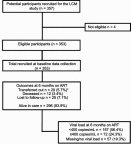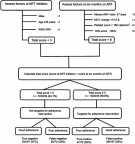Clinical predictor score to identify patients at risk of poor viral load suppression at six months on antiretroviral therapy: results from a prospective cohort study in Johannesburg, South Africa
- PMID: 31191029
- PMCID: PMC6511618
- DOI: 10.2147/CLEP.S197741
Clinical predictor score to identify patients at risk of poor viral load suppression at six months on antiretroviral therapy: results from a prospective cohort study in Johannesburg, South Africa
Abstract
Purpose: As countries work toward 90:90:90 targets, early identification of patients with inadequate response to antiretroviral therapy (ART) is critical for achieving optimal HIV treatment outcomes. We developed and evaluated a clinical prediction score (CPS) to identify HIV-positive patients at risk of poor viral load suppression at 6 months on ART. Patients and methods: We conducted a prospective cohort study of HIV-positive ART naïve adults (≥18 years) initiating standard first-line ART between February 2012 and April 2014 at Themba Lethu Clinic in Johannesburg, South Africa. We used Modified Poisson regression to estimate the association between patient characteristics and poor viral load suppression, defined as a viral load ≥400 copies/mL at 6 months on ART. We developed a CPS following the Spiegel Halter and Knill-Jones approach and determined the diagnostic accuracy compared to viral load as the "gold standard". We identified the optimal cutoff at which the CPS would identify those at risk of poor viral load suppression. Results: Among 353 patients, 67.7% had a viral load measurement at 6 months on ART and 30.1% of these were viremic (≥400 copies/mL). Male gender, platelet count <150 cells/mm3, ≥7 days late for ≥2 ARV visits, visual analog scale (VAS) <90% and <14.5 fL increase in mean cell volume from baseline to 6 months were included in the CPS. The optimal cutoff was 5 (≥5 vs <5; sensitivity [Se] 65.3%, specificity [Sp] 46.7%) and the CPS performed better than standard measures of adherence (eg, VAS Se 24.5%; Simplified Medication Adherence Questionnaire Se 26.5%). Conclusion: Our findings suggest a 6-month CPS may have the potential to identify patients at risk of poor viral load suppression. The CPS may be used to target patients who need intensive adherence support, with the caveat that there may be a three- to four-fold increase in the pool of patients identified for adherence counseling.
Keywords: algorithm; antiretroviral therapy; monitoring; resource limited; risk score; viral load.
Conflict of interest statement
DE reports grants from Health Economics and Epidemiology Research Office during the conduct of the study. The authors report no other conflicts of interest in this work.
Figures
Similar articles
-
Markers of poor adherence among adults with HIV attending Themba Lethu HIV Clinic, Helen Joseph Hospital, Johannesburg, South Africa.Trans R Soc Trop Med Hyg. 2016 Dec 1;110(12):696-704. doi: 10.1093/trstmh/trx003. Trans R Soc Trop Med Hyg. 2016. PMID: 28938050 Free PMC article.
-
The right combination - treatment outcomes among HIV-positive patients initiating first-line fixed-dose antiretroviral therapy in a public sector HIV clinic in Johannesburg, South Africa.Clin Epidemiol. 2017 Dec 18;10:17-29. doi: 10.2147/CLEP.S145983. eCollection 2018. Clin Epidemiol. 2017. PMID: 29296098 Free PMC article.
-
Predictors of switch to and early outcomes on third-line antiretroviral therapy at a large public-sector clinic in Johannesburg, South Africa.AIDS Res Ther. 2018 Apr 10;15(1):10. doi: 10.1186/s12981-018-0196-9. AIDS Res Ther. 2018. PMID: 29636106 Free PMC article.
-
CD4 criteria improves the sensitivity of a clinical algorithm developed to identify viral failure in HIV-positive patients on antiretroviral therapy.J Int AIDS Soc. 2014 Sep 15;17(1):19139. doi: 10.7448/IAS.17.1.19139. eCollection 2014. J Int AIDS Soc. 2014. PMID: 25227265 Free PMC article.
-
Study of the impact of HIV genotypic drug resistance testing on therapy efficacy.Verh K Acad Geneeskd Belg. 2001;63(5):447-73. Verh K Acad Geneeskd Belg. 2001. PMID: 11813503 Review.
Cited by
-
Conceptualising engagement with HIV care for people on treatment: the Indicators of HIV Care and AntiRetroviral Engagement (InCARE) Framework.BMC Health Serv Res. 2023 May 4;23(1):435. doi: 10.1186/s12913-023-09433-4. BMC Health Serv Res. 2023. PMID: 37143067 Free PMC article. Review.
-
Men missing from the HIV care continuum in sub-Saharan Africa: a meta-analysis and meta-synthesis.J Int AIDS Soc. 2022 Mar;25(3):e25889. doi: 10.1002/jia2.25889. J Int AIDS Soc. 2022. PMID: 35324089 Free PMC article. Review.
-
Secondary Overtriage of Trauma Patients to a Central Hospital in Malawi.World J Surg. 2020 Jun;44(6):1727-1735. doi: 10.1007/s00268-020-05426-0. World J Surg. 2020. PMID: 32100065
-
Using a Self-Administered Electronic Adherence Questionnaire to Identify Poor Adherence Amongst Adolescents and Young Adults on First-Line Antiretroviral Therapy in Johannesburg, South Africa.Patient Prefer Adherence. 2020 Jan 22;14:133-151. doi: 10.2147/PPA.S210404. eCollection 2020. Patient Prefer Adherence. 2020. PMID: 32021124 Free PMC article.
-
Measuring patient engagement with HIV care in sub-Saharan Africa: a scoping study.J Int AIDS Soc. 2022 Oct;25(10):e26025. doi: 10.1002/jia2.26025. J Int AIDS Soc. 2022. PMID: 36285618 Free PMC article. Review.
References
-
- United Nations Against AIDS (UNAIDS) data 2018. Available from: http://www.unaids.org/sites/default/files/media_asset/unaids-data-2018_e.... Assessed April 11, 2019.
-
- Machtinger EL, Bangsberg DR. Seven steps to better adherence: a practical approach to promoting adherence to antiretroviral therapy. AIDS Read. 2007;17(1):43–51. Available from: https://www.ncbi.nlm.nih.gov/pubmed?cmd=historysearch&querykey=1. - PubMed
-
- The Fifth South African National HIV Prevalence Incidence behaviour and communication survey_ 2017.pdf. Available from: https://serve.mg.co.za/content/documents/2018/07/17/7M1RBtUShKFJbN3NL1Wr.... Accessed April 11, 2019.
-
- World Health Organization, Geneva, 2015. Guideline on when to start antiretroviral therapy and on pre-exposure prophylaxis for HIV. Available from: http://www.ncbi.nlm.nih.gov/books/NBK327115/. Accessed June 2018. - PubMed
Grants and funding
LinkOut - more resources
Full Text Sources
Research Materials
Miscellaneous



